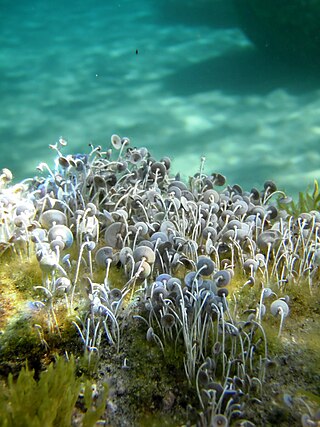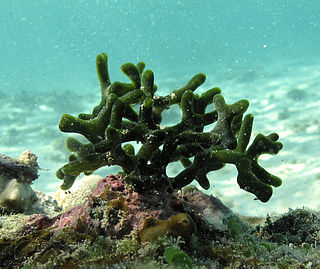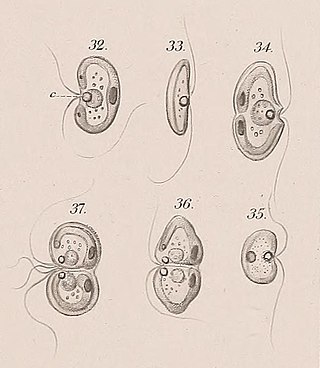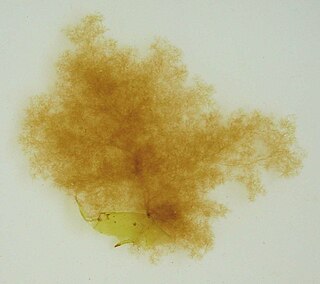
Chlorophyta is a taxon of green algae informally called chlorophytes. The name is used in two very different senses, so care is needed to determine the use by a particular author. In older classification systems, it is a highly paraphyletic group of all the green algae within the green plants (Viridiplantae) and thus includes about 7,000 species of mostly aquatic photosynthetic eukaryotic organisms. In newer classifications, it is the sister clade of the streptophytes/charophytes. The clade Streptophyta consists of the Charophyta in which the Embryophyta emerged. In this latter sense the Chlorophyta includes only about 4,300 species. About 90% of all known species live in freshwater. Like the land plants, green algae contain chlorophyll a and chlorophyll b and store food as starch in their plastids.

Acetabularia is a genus of green algae in the family Polyphysaceae. Typically found in subtropical waters, Acetabularia is a single-celled organism, but gigantic in size and complex in form, making it an excellent model organism for studying cell biology. In form, the mature Acetabularia resembles the round leaves of a nasturtium, is 4 to 10 centimetres tall and has three anatomical parts: a bottom rhizoid that resembles a set of short roots; a long stalk in the middle; and a top umbrella of branches that may fuse into a cap. Unlike other giant unicellular organisms, which are multinucleate, members of this genus a single nucleus located in the rhizoid and allows the cell to regenerate completely if its cap is removed. The caps of two Acetabularia may also be exchanged, even from two different species. In addition, if a piece of the stem is removed, with no access to the nucleus in the rhizoid, this isolated stem piece will also grow a new cap.

Halimeda is a genus of green macroalgae. The algal body (thallus) is composed of calcified green segments. Calcium carbonate is deposited in its tissues, making it inedible to most herbivores. However one species, Halimeda tuna, was described as pleasant to eat with oil, vinegar, and salt.

Codium is a genus of edible green macroalgae under the order Bryopsidales. The genus name is derived from a Greek word that pertains to the soft texture of its thallus. One of the foremost experts on Codium taxonomy was Paul Claude Silva at the University of California, Berkeley. P.C. Silva was able to describe 36 species for the genus and in honor of his work on Codium, the species C. silvae was named after the late professor.

Leathesia marina (Lyngbye) Decaisne, 1842, previously known as Leathesia difformis Areschoug, 1847, commonly known as the sea cauliflower the sea potato, and brown brains is a species of littoral brown algae in the class Phaeophyceae and the order Ectocarpales, which is commonly attached to other seaweeds and sometimes rocks. When young, the organism is solid but as it matures it becomes hollow and somewhat convoluted and has the appearance of a small leathery brown bag about the same size as a tennis ball. The texture is rubbery and the outer surface smooth.

Selenastraceae is a family of green algae in the order Sphaeropleales. Members of this family are common components of the phytoplankton in freshwater habitats worldwide. A few species have been found in brackish and marine habitats, such as in the Baltic Sea.
Acrochaete is a genus of marine green algae of the family Ulvellaceae known to live as endoparasites of other algae, although they may eventually be found growing on inorganic substrates, such as rocks.

Nephroselmis is a genus of green algae. It has been placed in the family Nephroselmidaceae, although a 2009 study suggests that it should be separated into its own class, Nephroselmidophyceae. One species can be an endosymbiont of Hatena arenicola.
Struvea is a genus of green macroalgae in the family Boodleaceae.

Udotea is a genus of green algae in the family Udoteaceae.

The genus Umbraulva, which is a green alga within the Ulvaceae family, was proposed by Bae and Lee in 2001. Three additional species, including U. kuaweuweu, which was subsequently transferred to another genus, have been added to the genus since it originally had the three species that were initially examined to form the genus. Umbraulva species grow upon hard substrates, and inhabit deep subtidal areas. Species within this genus are widely distributed, and have been identified in Asia, Europe, Hawaii, and New Zealand. The morphological traits of Umbraulva vary among species, but commonly, Umbraulva are macroscopic with olive green blades containing the photosynthetic pigment siphonaxanthin. The blades are flattened and ellipsoid in shape, or are narrow and oval shaped, with perforations and/or lobes present throughout the blade. As Umbraulva often appear very similar in morphology to closely related groups, the main manner in which Umbraulva was differentiated from related groups was through the divergence of ITS and partial SSU rDNA sequences from those of other Ulva species. Umbraulva is closely related to Ulva, which due to wide distributions, high carbohydrate levels, and a lack of lignin, is a good candidate for use in biofuel, bioremediation, carbon sequestration, and animal feed production.

Haematococcus pluvialis is a freshwater species of Chlorophyta from the family Haematococcaceae. This species is well known for its high content of the strong antioxidant astaxanthin, which is important in aquaculture, and cosmetics. The high amount of astaxanthin is present in the resting cells, which are produced and rapidly accumulated when the environmental conditions become unfavorable for normal cell growth. Examples of such conditions include bright light, high salinity, and low availability of nutrients. Haematococcus pluvialis is usually found in temperate regions around the world. Their resting cysts are often responsible for the blood-red colour seen in the bottom of dried out rock pools and bird baths. This colour is caused by astaxanthin which is believed to protect the resting cysts from the detrimental effect of UV-radiation, when exposed to direct sunlight.

Ectocarpus siliculosus is a filamentous brown alga. Its genome was the first brown macroalgal genome to be sequenced, with the expectation that E. siliculosus will serve as a genetic and genomic model for brown macroalgae.

Pediastrum duplex is a species of fresh water green algae in the genus Pediastrum. It is the type species of the genus Pediastrum.

Ectocarpus is a genus of filamentous brown alga that is a model organism for the genomics of multicellularity. Among possible model organisms in the brown algae, Ectocarpus was selected for the relatively small size of its mature thallus and the speed with which it completes its life cycle. Tools available for Ectocarpus as a model species include a high quailty genome sequence and both forward and reverse genetic methodologies, the latter based on CRISPR-Cas9.
Kallymenia ercegovicii a red algae species first discovered in the Mediterranean Sea, in the coast of Croatia.

Wendy Alison Nelson is a New Zealand marine scientist and world expert in phycology. She is New Zealand's leading authority on seaweeds. Nelson is particularly interested in the biosystematics of seaweeds/macroalgae of New Zealand, with research on floristics, evolution and phylogeny, as well as ecology, and life history studies of marine algae. Recently she has worked on the systematics and biology of red algae including coralline algae, distribution and diversity of seaweeds in harbours and soft sediment habitats, and seaweeds of the Ross Sea and Balleny Islands.

Michael Dominic Richard Guiry, is an Irish botanist, who specialises in phycology (algae). See for example the articles. He is the founder and director of the algal database, AlgaeBase.
Entwisleia is a monotypic genus in the red algae family, Entwisleiaceae. There is just one species in this genus, Entwisleia bella, from south-eastern Tasmania and represents both a new family and a new order (Entwisleiales) in the Nemaliophycidae.

Cochlodinium is a genus of dinoflagellates belonging to the family Gymnodiniaceae. Over the past two decades, harmful algea blooms (HABs) caused by Cochlodinium had occurred more often and expanded from Southeast Asia to regions such as the rest of Asia, North America and Europe.















